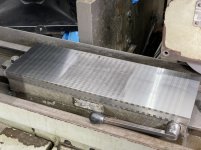michiganbuck
Diamond
- Joined
- Jun 28, 2012
- Location
- Mt Clemens, Michigan 48035
The Op said the base is Aluminum and Aluminum is not easy to grind.
A shame he did not notice the bow before he took it apart. He could take it apart again but a good chance the warp/bow was in the chuck from a prior chuck top grind.
I think the aluminum base should be milled to flat.
To do that one would set the mag chuck upside-down on a honed mill table with the mag turned off. Sharpie mark the mill footprint, Take it off and indicate four places where shims are intended to be placed and draw a map of that finding.
Place the chuck back on the mill and feel and place shims at the shim intended places so the Aluminum concave is facing up and the chuck is zero / zero at the far (long travel) ends.
The bow facing down should be just touching the table, If off the mill table then a shim should be slipped under to make it solid. A very sharp/new end mill cotter should mill the aluminum base to flat.
A fly cutter could be used but I think that it may make a slight concave or convex that would/may need more attention/work to make it flat.
After done the aluminum base should set on a surface plate being close to flat.
I like a mag chuck to set on the set pad dead flat or with a little pressure at the middle bottom, so not to have a hollow at the underside of the chuck.
Once the chuck bottom it can be put on the set pad and WET top grinding be done.
Yes, I can grind a chuck dry and many good grinder hands can do that,but it is a poor method because evnen a chuck that feel not hot may have some swelling..and burning a chuck top can put in permanant stress that remain even after the burn is ground away.
.
A shame he did not notice the bow before he took it apart. He could take it apart again but a good chance the warp/bow was in the chuck from a prior chuck top grind.
I think the aluminum base should be milled to flat.
To do that one would set the mag chuck upside-down on a honed mill table with the mag turned off. Sharpie mark the mill footprint, Take it off and indicate four places where shims are intended to be placed and draw a map of that finding.
Place the chuck back on the mill and feel and place shims at the shim intended places so the Aluminum concave is facing up and the chuck is zero / zero at the far (long travel) ends.
The bow facing down should be just touching the table, If off the mill table then a shim should be slipped under to make it solid. A very sharp/new end mill cotter should mill the aluminum base to flat.
A fly cutter could be used but I think that it may make a slight concave or convex that would/may need more attention/work to make it flat.
After done the aluminum base should set on a surface plate being close to flat.
I like a mag chuck to set on the set pad dead flat or with a little pressure at the middle bottom, so not to have a hollow at the underside of the chuck.
Once the chuck bottom it can be put on the set pad and WET top grinding be done.
Yes, I can grind a chuck dry and many good grinder hands can do that,but it is a poor method because evnen a chuck that feel not hot may have some swelling..and burning a chuck top can put in permanant stress that remain even after the burn is ground away.
.
Last edited:




